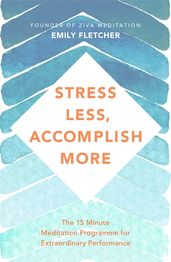How to meditate: where to start and what are the benefits?
If you're new to meditation, knowing where to start can be overwhelming. But in times of stress and uncertainty, a simple meditation can help to calm our minds. Here is an introduction to meditation and its benefits, as well as an easy meditation for beginners.

Research into the benefits of meditation shows that regularly meditating can have a positive impact on our bodies and minds, something which is particularly important in these difficult and uncertain times. A simple meditation can help to calm the nervous system and help us to deal with racing thoughts. Here, we explain how to meditate with an easy meditation for beginners, and Emily Fletcher, author of Stress Less, Accomplish More, tells us more about the benefits of meditation and her method the Ziva Technique.
How to meditate: a simple meditation for beginners
Take a comfortable seat. This might be a chair or sitting on your bed, wherever you'd like just so long as you're able to sit upright.
Close your eyes. Take a slow, deep breath. Then another. With each exhale, let your muscles soften a little further.
- Take a moment just to settle where you are. What can you hear? What can you smell?
- Slow your breathing and take stock of how you feel, both emotionally and physically. Just observe this, don't judge it as good or bad or try to change it, simply notice it. You might be feeling stressed, or happy, or tired, or relaxed, or bored . . . try not to get wrapped up in any stories of why you might feel this way, just check-in and notice it with curiosity.
- Now, start with a three-part breath. This is a simple breathing technique that helps you to take long, deep breaths to help relax your nervous system. Place one hand on your lower tummy, and the other at the top of your chest just beneath your collarbones. Start on an inhale, feel your breath expanding your lower tummy, then your ribs, then all the way up to your collarbone as though you're breathing in in a wave. Take a slight pause when your lungs feel completely full. Then exhale from your collarbones, then your ribs, then all the way out from your lower tummy, and take a slight pause as your lungs feel completely empty.
- With each wave, concentrate on the feeling of the breath in your body, feel it expanding beneath your hands. When you feel your mind wander (as it naturally will), just notice this and come back to the breath when you can. This might happen over and over – and it's no bad thing!
- Take several rounds like this, for as long as you'd like. You may not be used to taking such deep breaths continuously, so just do this for as long as feels comfortable. When you're ready, let your breathing return to normal.
- Now take a scan of your body, starting from your feet, feeling them against the floor, and work your way up to the crown of your head. How does each part of your body feel physically? Notice any areas of tension in your body and any areas of softness. Spend a little while here, take your time and be curious without judgement. As before, when your mind starts to wander, just gently bring it back to your body scan and pick up where you left off.
- Take a few breaths when you finish your body scan. You can stay here for as long as you like, again concentrating on your breath, or just enjoying the stillness.
- Whenever you're ready, flutter your eyes open – and you're all done! It really is as easy as that!
The benefits of meditation, from Stress Less, Accomplish More author, Emily Fletcher
Right now, it seems everyone is talking about meditation. And at this point, you probably know you should be doing it. You've heard the seemingly endless amounts of neuroscience behind it; you've read the articles about the countless benefits. Maybe you've even dabbled with free mindfulness apps or a drop-in studio.
But now that we know for sure it's so good for us, why do so many of us still think we're too busy to meditate? Especially since many of the world's top achievers have outed themselves as meditators, including Bill Gates, Ray Dalio, Jack Dorsey and Oprah.
It's time to face facts: the ROI on time spent meditating is too great to ignore any longer.
Right now, meditation is undergoing the same transformation that exercise did in the '70s. The evidence is pretty stacked -- meditation will indeed make your life better. Why? Because it eliminates stress from your brain and body. And eliminating that stress helps you to sleep better, have a sharper focus, better decision-making skills, a stronger immune system, increased productivity, and even better sex.
So while you may choose to not have a meditation practice, you'll inevitably be missing out on a ton of benefits by doing so.
Ask yourself: can you afford not to meditate?
About the Ziva Technique
One of the biggest misconceptions we hear about meditation is that you have to “clear your mind” in order to be successful at it. This. Is. A. Myth. Here's the thing — the mind thinks involuntarily in the same way that your heart beats involuntarily. So giving your mind a command to stop thinking is as futile as giving your heart a command to stop beating.
Ziva teaches a meditation style designed for people with busy minds and busy lives, and thoughts are just part of the process. In fact, with The Ziva Technique, the more effortless it is, the better.
The Ziva Technique is a powerful trifecta of mindfulness, meditation and manifesting. The mindfulness portion is like the appetizer course, consisting of techniques to immediately draw your awareness into the present moment. Through the use of breathing techniques and an exercise, we call Come To Your Senses students quickly slow their heart rate and feel more grounded.
Next, there is the main course — the meditation portion — which will allow you to easily drift into a verifiable fourth state of consciousness. This is where the magic happens — your metabolic rate slows, your breathing gets a little shallower, and you drift into a rest that is 5x deeper than sleep. Your brain and body will flood with dopamine and serotonin and within 40 seconds, you will be chipping away at the backlog of stresses you have saved in your nervous system.
Last but not least, the dessert portion is manifesting, which sounds scarier than it is. In fact, manifesting is all about getting really clear on your dreams, goals or desires so you can begin to make active choices in your waking state to bring those dreams into fruition.
The most enticing part of this technique, which you can learn in my new book, Stress Less, Accomplish More: Meditation for Extraordinary Performance, is that once you learn it, you can't unlearn it. It's yours for life. No apps, wifi, or drop-in studios needed. It's a self-sufficient practice that you can do anywhere and everywhere, including at your desk, on the train, or anywhere you can sit quietly in a chair.
If you're looking for more techniques to help you deal with life's daily stresses, check out this episode of Book Break for seven tips to help you stress less:
Stress Less, Accomplish More
by Emily Fletcher
In Stress Less, Accomplish More Emily Fletcher shares the Ziva Technique - an ancient meditation technique perfect for busy lives. Perfect for modern life, the technique will help to help to reduce stress and improve mental clarity and performance. Designed for busy lives, this technique will work any place, any time.



